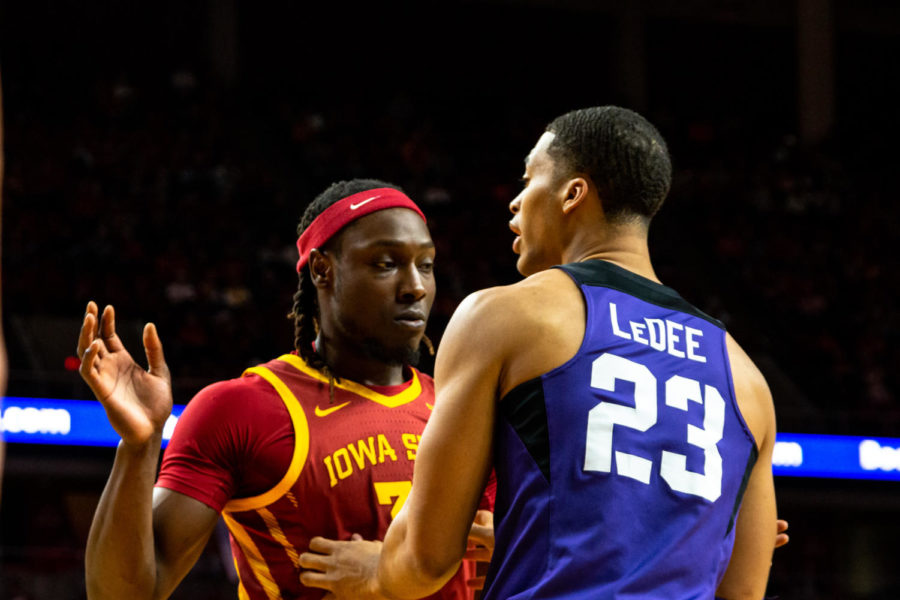Takeaways: Change in the game plan still ends in a loss
February 29, 2020
It was another textbook Iowa State loss to Oklahoma State on Saturday, but not without plenty of changes in the game plan to make the game a back and forth battle to start.
In the 73-61 loss to the Cowboys, Iowa State was faced with having to explore a new approach on how to beat the Cowboys with so much change taking place since the two teams last met on Jan. 21.
No Tyrese Haliburton. New point guard roles. New starting five. Everything was turned on its head from the last time these two teams met — and the Cyclones started off like they were ready to change everything up.
Rasir Bolton was the primary ball handler much more than any other game since Haliburton went down and found his way to the cup with ease. Solomon Young was held in check while also not receiving close to the heavy dosage of touches in the paint he saw Jan. 21 against the Cowboys. Threes were not falling. Yet Iowa State found itself leading for pretty much the first 11 minutes of the first half.
But the Cyclones’ two biggest enemies showed up to spoil the success in the new game plan: turnovers and little to no production from key players.
From the 9:57 mark of the first half on, Iowa State would never have the lead again.
The poor play that continues to stop the Cyclones from playing their best is nothing new, rather, it’s just become a part of their identity time and again this season. Even with a new approach, Iowa State still found itself a victim to the biggest issues it’s been plagued with during its rocky season.
Bolton comes out on fire
The main force behind the quick start for Iowa State started with the aggressive play of Bolton.
Bolton opened the game on a mission to score.
First possession for Iowa State: Bolton layup. Second possession: Bolton three point basket. Third possession: Another Bolton layup. Bolton scored Iowa State’s first seven points, forcing Oklahoma State to call timeout two minutes into the game.
Bolton found himself in the midst of attack mode primarily from his new role of bringing the ball up and working the offense as the main point guard. Prentiss Nixon was given the ball handling responsibilities for a majority of time since Haliburton’s injury, leaving Bolton as an off-ball option that uses ball screens to his advantage to attack if he can.
The sophomore put up 14 first half points, with Nixon having the second most on the team with five points at the break.
Bolton’s success in the first half showed up at the foul line. Bolton went to the foul line five times, shooting 5-5 to start. The attacking style of play that Head Coach Steve Prohm described as the best downhill player on the team had been in a downswing compared to the high volume Bolton had to start the season. Coming into Saturday’s game, Bolton had 11 free throw attempts in his last four games.
The success at the foul line and attacking the rim would reach a screeching halt by the time the second half began.
Bolton’s second half would turn out to be nothing like the Bolton of the first 20 minutes of action. Bolton shot 1-7 from the field and 0-3 from deep with no trips to the charity stripe.
Bolton would finish with 16 points on 5-14 shooting, 1-6 from three with four turnovers against the Cowboys. Scoring at a high clip hasn’t come that often for Bolton over the past month, with his 16-point outing being his first game with over 13 points since Feb. 5 against West Virginia when he had 18 points.
Continued turnovers
What would an Iowa State game be without some turnovers?
The Cyclones gave away 12 first half turnovers, with just four assists. Iowa State would quiet things down in the turnover margin in the second half, finishing with 17 for the game. In the first matchup with the Cowboys, Iowa State totaled 19 turnovers.
Nixon racked up four in the first half alone, Bolton would end with four and both Michael Jacobson and Young would have three each.
This is now the fifth time this season with over 17 turnovers for the Cyclones.
With an upcoming matchup against West Virginia’s press defense that forced 14 turnovers out of Iowa State, the continued issue of high volume turnovers might not be going away any time soon.
Road woes
0-10. That is Iowa State’s current record on the road this season, a mark Iowa State hasn’t reached since the 2017-18 season when the Cyclones ended with an 0-10 road record. This year’s team could be on their way to being a part of history — and not the good kind.
Iowa State hasn’t had more than 10 losses on the road since the 2001-02 season in which the Cyclones ended 1-12. So that means while this year’s team might not be in the running for the worst record on the road over the last decade, second-worst is still in play.
In the 2007-08 season, Iowa State ended with a 1-10 road record, so with one last chance to grab a win on the road, Iowa State could either end tied for the third worst road record over the last decade or could etch a place into the second worst road record if they fall to 0-11 this season.
Iowa State’s last chance to grab itself a road win will be against Kansas State, a team it already beat by 10 earlier in the season, in the regular season finale on Saturday. The Wildcats hold the the worst record in the Big 12 (2-14) and have lost nine games in a row.







